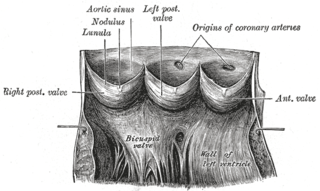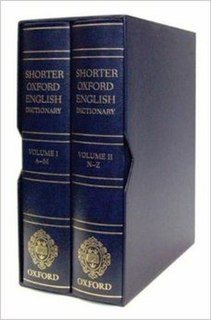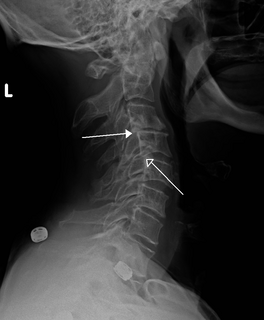Paroxysmal attacks or paroxysms are a sudden recurrence or intensification of symptoms, such as a spasm or seizure. These short, frequent symptoms can be observed in various clinical conditions. They are usually associated with multiple sclerosis or pertussis, but they may also be observed in other disorders such as encephalitis, head trauma, stroke, asthma, trigeminal neuralgia, breath-holding spells, epilepsy, malaria, tabes dorsalis, and Behçet's disease, paroxysmal nocturnal hemoglobinuria (PNH). It has also been noted as a symptom of gratification disorder in children.
An inotrope is an agent that alters the force or energy of muscular contractions. Negatively inotropic agents weaken the force of muscular contractions. Positively inotropic agents increase the strength of muscular contraction.

An aortic sinus, also known as a sinus of Valsalva, is one of the anatomic dilations of the ascending aorta, which occurs just above the aortic valve. These widenings are between the wall of the aorta and each of the three cusps of the aortic valve.

The Shorter Oxford English Dictionary (SOED) is an English language dictionary published by the Oxford University Press. The SOED is a two-volume abridgement of the twenty-volume Oxford English Dictionary (OED).

The Oxford Advanced Learner's Dictionary (OALD) was the first advanced learner's dictionary of English. It was first published in 1948. It is the largest English-language dictionary from Oxford University Press aimed at a non-native audience. Users with a more linguistic interest, requiring etymologies or copious references, usually prefer the Concise Oxford English Dictionary, or indeed the comprehensive Oxford English Dictionary, or other dictionaries aimed at speakers of English with native-level competence.

A retrolisthesis is a posterior displacement of one vertebral body with respect to the subjacent vertebra to a degree less than a luxation (dislocation). Retrolistheses are most easily diagnosed on lateral x-ray views of the spine. Views where care has been taken to expose for a true lateral view without any rotation offer the best diagnostic quality.
Vasomotor refers to actions upon a blood vessel which alter its diameter. More specifically, it can refer to vasodilator action and vasoconstrictor action.

Carditis is the inflammation of the heart.

The tela choroidea is a region of meningeal pia mater that adheres to the underlying ependyma, and gives rise to the choroid plexus in each of the brain’s four ventricles. Tela is Latin for woven and is used to describe a web-like membrane or layer. The tela choroidea is a very thin part of the loose connective tissue of pia mater overlying and closely adhering to the ependyma. It has a rich blood supply. The ependyma and vascular pia mater – the tela choroidea, form regions of minute projections known as a choroid plexus that projects into each ventricle. The choroid plexus produces most of the cerebrospinal fluid of the central nervous system that circulates through the ventricles of the brain, the central canal of the spinal cord, and the subarachnoid space. The tela choroidea in the ventricles forms from different parts of the roof plate in the development of the embryo.
Hypersalivation, or ptyalism, also known as sialorrhea or hypersialosis is the excessive production of saliva. It has also been defined as increased amount of saliva in the mouth, which may also be caused by decreased clearance of saliva.

Chlorcyclizine is a first-generation antihistamine of the diphenylmethylpiperazine group marketed in the United States and certain other countries. It is used primarily to treat allergy symptoms such as rhinitis, urticaria, and pruritus, and may also be used as an antiemetic. In addition to its antihistamine effects, chlorcyclizine also has some anticholinergic, antiserotonergic, and local anesthetic properties. It also has been studied as a potential treatment for various flaviviruses like Hepatitis C and Zika Virus.

The centrum semiovale, semioval center or centrum ovale is the central area of white matter found underneath the cerebral cortex. The white matter, located in each hemisphere between the cerebral cortex and nuclei, as a whole has a semioval shape. It consists of cortical projection fibers, association fibers and cortical fibers. It continues ventrally as the corona radiata.

Lamina affixa is a layer of epithelium growing on the surface of the thalamus and forming the floor of the central part of lateral ventricle, on whose medial margin is attached the choroid plexus of the lateral ventricle; it covers the superior thalamostriate vein and the superior choroid vein. The torn edge of this plexus is called the tela choroidea.
Platypnea or platypnoea is shortness of breath (dyspnea) that is relieved when lying down, and worsens when sitting or standing. It is the opposite of orthopnea. The condition was first described in 1949 and named in 1969.
Tubulopathy is a disease affecting the renal tubules of the nephron.
In immunology, the term sensitization is used for the following concepts:
Graham-Little syndrome is a cutaneous condition characterized by lichen planus-like skin lesions. It is named after Ernest Graham-Little.
Saunders is an American academic publisher based in the United States. It is currently an imprint of Elsevier.

The Oxford Dictionary of English (ODE) is a single-volume English dictionary published by Oxford University Press, first published in 1998 as The New Oxford Dictionary of English (NODE). The word "new" was dropped from the title with the Second Edition in 2003. This dictionary is not based on the Oxford English Dictionary (OED) and should not be mistaken for a new or updated version of the OED. It is a completely new dictionary which strives to represent as faithfully as possible the current usage of English words. The Revised Second Edition contains 355,000 words, phrases, and definitions, including biographical references and thousands of encyclopaedic entries. The Third Edition was published in August 2010, with some new words, including "vuvuzela".
Cecil Textbook of Medicine is a medical textbook published by Elsevier under the Saunders imprint. First released in 1927 as the Textbook of Medicine by Russell LaFayette Cecil, the book is one of the most prominent and widely consulted medical textbooks in the United States. Cecil Medicine is often compared with Harrison's Principles of Internal Medicine, which it predates by three decades. Approximately one third of its authors are changed with each new edition. It is currently in its 26th edition.